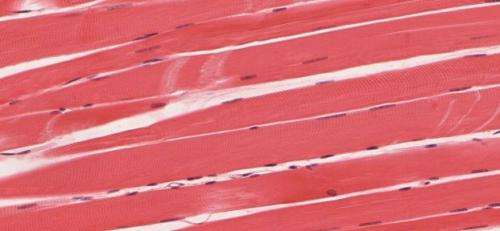New mouse model may speed identification of promising muscular dystrophy therapies

A Massachusetts General Hospital (MGH) research team has created a new mouse model of a common form of muscular dystrophy with the potential of rapidly distinguishing promising therapeutic drugs from those unlikely to be successful. In their report published in Nature Communications they also describe testing a novel antisense oligonucleotide drug—a synthetic nucleic acid strand that prevents transcription of a protein by binding to its mRNA molecule—that may more effectively block production of aberrant proteins.
"This novel fluorescent model allows monitoring of therapeutic drug activity simply by using a camera to take pictures of living mice," says Thurman Wheeler, MD, MGH Department of Neurology, senior author of the report. "By crossing an established mouse model of myotonic dystrophy type 1 with one that expresses either a red or green fluorescent protein in muscle, depending on the splicing of a target RNA sequence, we developed a model in which muscles appear mostly green before treatment and transition to mostly red after successful treatment."
The most common form of adult-onset muscular dystrophy, myotonic dystrophy has two subtypes. Type 1 (DM1) affects RNA splicing, the process that removes non-coding segments from an RNA molecule and determines precisely which protein is produced. The DM1-associated mutation affects splicing of RNAs encoding several important proteins in skeletal muscles along with proteins involved in insulin metabolism and cardiac function. Determining with existing animal models whether potential DM1 therapies could correct this aberrant splicing requires molecular analysis of muscle tissue, which is expensive, time consuming and requires a large number of animals to test each new drug.
Wheeler's team adapted an existing fluorescent-protein-based system developed for cellular studies into one in which the proteins were expressed only in skeletal muscle tissue. In this "bi-transgenic" mouse model, muscle fibers affected by the aberrant RNA splicing of DM1 fluoresce green while those in which splicing is appropriate fluoresce red. The ratio between the red and green signals indicates whether or not a potential therapy is correcting aberrant splicing.
The investigators first tested their model using an existing antisense oligonucleotide (ASO) that targets the RNA-mediated disease process in DM1. They were surprised to observe an increase of the red/green ratio beginning as early as three days after the ASO was injected into the animals' muscles, an increase that persisted for several weeks. Muscle tissue analysis 49 days after injection confirmed correction of the aberrant RNA splicing. Subcutaneous injection with another ASO known to correct RNA splicing defects in the original DM1 model produced a therapeutic effect, as indicated by the increased red/green ratio, as early as 14 days after the first of four injections, an effect that became more pronounced through the eighth dose on day 25.
Because previous studies testing ASOs as potential DM1 therapies were limited by a lack of sufficient drug concentration in muscle tissue, the MGH-based team tested a technology called ligand-conjugated antisense (LICA), which enhances delivery of a subcutaneously injected ASO to muscles throughout the body. Their LICA ASO—the first to be tested as a potential DM1 treatment—demonstrated therapeutic activity twice as fast as the unconjugated version of the same ASO, indicating a two-fold greater potency of the LICA drug.
"Our results support further development of LICA technology for the treatment of DM1. In addition to new ASOs, other treatment strategies such as small-molecule candidate drugs, siRNAs and protein-based therapies also could be tested using this model. Long term it would be ideal for testing gene-editing therapeutic approaches, as they become available," says Wheeler, an assistant professor of Neurology at Harvard Medical School. "Faster identification of promising therapies and early rejection of failed candidates will help make effective treatments available to patients sooner and at lower developmental costs."
More information: Ningyan Hu et al, Non-invasive monitoring of alternative splicing outcomes to identify candidate therapies for myotonic dystrophy type 1, Nature Communications (2018). DOI: 10.1038/s41467-018-07517-y
















